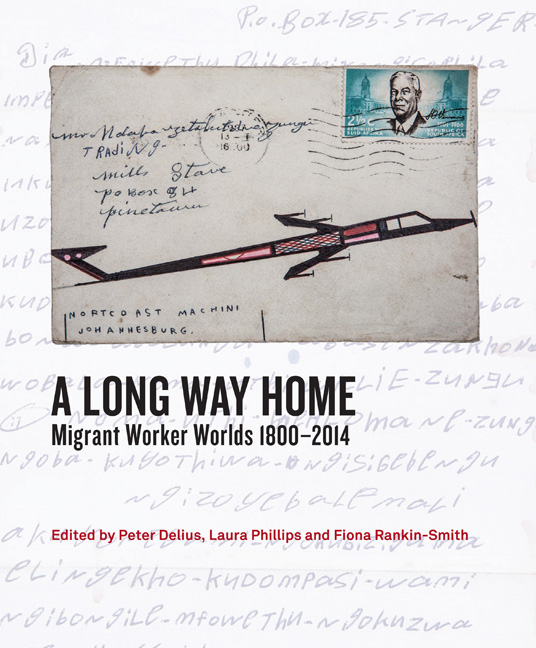Book contents
- Frontmatter
- Contents
- Acknowledgements
- Introduction: Highlighting Migrant Humanity
- Chapter 1 Ngezinyawo - Migrant Journeys
- Chapter 2 Slavery, Indenture and Migrant Labour: Maritime Immigration from Mozambique to the Cape, c.1780–1880
- Chapter 3 Walking 2 000 Kilometres to Work and Back: The Wandering Bassuto by Carl Richter
- Chapter 4 A Century of Migrancy from Mpondoland
- Chapter 5 The Migrant Kings of Zululand
- Chapter 6 The Art of Those Left Behind: Women, Beadwork and Bodies
- Chapter 7 The Illusion of Safety: Migrant Labour and Occupational Disease on South Africa's Gold Mines
- Chapter 8 ‘The Chinese Experiment’: Images from the Expansion of South Africas ‘Labour Empire’
- Chapter 9 ‘Stray Boys’: The Kruger National Park and Migrant Labour
- Chapter 10 Surviving Drought: Migrancy and the Homestead Economy
- Chapter 11 Migrants from Zebediela and Shifting Identities on the Rand, 1930s–1970s
- Chapter 12 Verwoerd's Oxen: Performing Labour Migrancy in Southern Africa
- Chapter 13 ‘Give My Regards to Everyone at Home Including Those I No Longer Remember’: The Journey of Tito Zungu's Envelopes
- Chapter 14 Sophie and the City: Womanhood, Labour and Migrancy
- Chapter 15 Bungityala
- Chapter 16 Migrants: Vanguard of the Worker's Struggles?
- Chapter 17 Debt or Savings? Of Migrants, Mines and Money
- Chapter 18 Post-Apartheid Migrancy and the Life of a Pondo Mineworker
- Notes on Contributors
- List of Figures and Tables
- Index
Chapter 10 - Surviving Drought: Migrancy and the Homestead Economy
Published online by Cambridge University Press: 04 July 2018
- Frontmatter
- Contents
- Acknowledgements
- Introduction: Highlighting Migrant Humanity
- Chapter 1 Ngezinyawo - Migrant Journeys
- Chapter 2 Slavery, Indenture and Migrant Labour: Maritime Immigration from Mozambique to the Cape, c.1780–1880
- Chapter 3 Walking 2 000 Kilometres to Work and Back: The Wandering Bassuto by Carl Richter
- Chapter 4 A Century of Migrancy from Mpondoland
- Chapter 5 The Migrant Kings of Zululand
- Chapter 6 The Art of Those Left Behind: Women, Beadwork and Bodies
- Chapter 7 The Illusion of Safety: Migrant Labour and Occupational Disease on South Africa's Gold Mines
- Chapter 8 ‘The Chinese Experiment’: Images from the Expansion of South Africas ‘Labour Empire’
- Chapter 9 ‘Stray Boys’: The Kruger National Park and Migrant Labour
- Chapter 10 Surviving Drought: Migrancy and the Homestead Economy
- Chapter 11 Migrants from Zebediela and Shifting Identities on the Rand, 1930s–1970s
- Chapter 12 Verwoerd's Oxen: Performing Labour Migrancy in Southern Africa
- Chapter 13 ‘Give My Regards to Everyone at Home Including Those I No Longer Remember’: The Journey of Tito Zungu's Envelopes
- Chapter 14 Sophie and the City: Womanhood, Labour and Migrancy
- Chapter 15 Bungityala
- Chapter 16 Migrants: Vanguard of the Worker's Struggles?
- Chapter 17 Debt or Savings? Of Migrants, Mines and Money
- Chapter 18 Post-Apartheid Migrancy and the Life of a Pondo Mineworker
- Notes on Contributors
- List of Figures and Tables
- Index
Summary
Just below the foothills of the northern Drakensberg mountain range, where it forms an arc around the lowveld, lay a number of scattered settlements, including Makharingwe, Mafarana, Morogolotsi and Banana. This was the agriculturally favoured, western part of the rural Letaba district, which became drier, less hospitable and more sparsely populated further east and north. ‘Village’ is hardly the right word for these settlements as they were in the 1930s and 1940s, when the nearest neighbour could live two kilometres away and the bush encroached on the fields and gardens surrounding each homestead. There were few ‘village’ shops and many people had to walk more than a day to buy the luxuries they supplied. The route to the shops from these scattered settlements was normally a footpath through the bush, as there were very few roads. Only the wealthiest families had scotch-carts, a few more had horses and the sound of a motorbike or car had people running in terror from what could only be the ‘Boers’. Many of the roads were impassable during the rainy season. The only public transport out of the district was a hair-raising train ride, endured in grim silence until the mountain passes were safely cleared, when the mood was lightened by relieved laughter and chatting.
These ‘villages’ were home to a number of old women, born in the 1920s and 1930s, who now live in Dan Village, where they were moved during the villagisation schemes of the 1960s. Most grew up in the low-lying, but relatively fertile lands in the area governed by Muhlaba, head of the Nkuna tribal authority, but some grew up further away in the ‘Sotho’ areas, closer to the foothills of the Drakensburg. I interviewed a few of these women in 2012 and others were interviewed for me by Ripfumelo Mushwana, the granddaughter of one of the women. Their life stories, particularly their descriptions of life in the 1930s and 1940s, form the basis of this chapter, along with documentary material from the period.
Using these interviews, I look at labour migrancy from the perspective of the homesteads that lay scattered in this region. That migrants’ remittances were ‘the life-blood of the reserve economy’ is well known.
- Type
- Chapter
- Information
- A Long Way HomeMigrant Worker Worlds 1800–2014, pp. 144 - 154Publisher: Wits University PressPrint publication year: 2014

